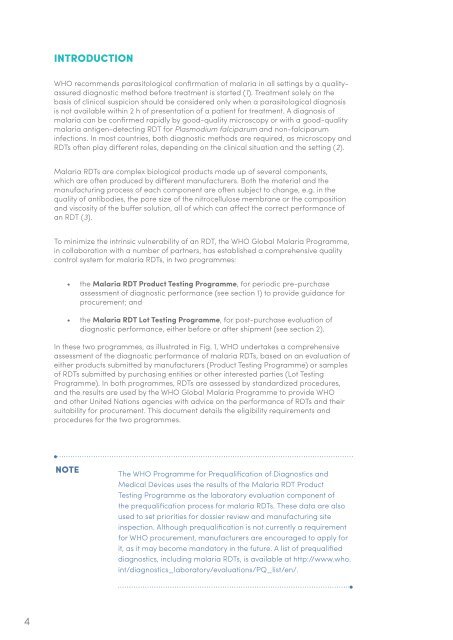WHO-2015_Procedures-malaria-RDT-productlot-testing
WHO-2015_Procedures-malaria-RDT-productlot-testing
WHO-2015_Procedures-malaria-RDT-productlot-testing
You also want an ePaper? Increase the reach of your titles
YUMPU automatically turns print PDFs into web optimized ePapers that Google loves.
Introduction<br />
<strong>WHO</strong> recommends parasitological confirmation of <strong>malaria</strong> in all settings by a qualityassured<br />
diagnostic method before treatment is started (1). Treatment solely on the<br />
basis of clinical suspicion should be considered only when a parasitological diagnosis<br />
is not available within 2 h of presentation of a patient for treatment. A diagnosis of<br />
<strong>malaria</strong> can be confirmed rapidly by good-quality microscopy or with a good-quality<br />
<strong>malaria</strong> antigen-detecting <strong>RDT</strong> for Plasmodium falciparum and non-falciparum<br />
infections. In most countries, both diagnostic methods are required, as microscopy and<br />
<strong>RDT</strong>s often play different roles, depending on the clinical situation and the setting (2).<br />
Malaria <strong>RDT</strong>s are complex biological products made up of several components,<br />
which are often produced by different manufacturers. Both the material and the<br />
manufacturing process of each component are often subject to change, e.g. in the<br />
quality of antibodies, the pore size of the nitrocellulose membrane or the composition<br />
and viscosity of the buffer solution, all of which can affect the correct performance of<br />
an <strong>RDT</strong> (3).<br />
To minimize the intrinsic vulnerability of an <strong>RDT</strong>, the <strong>WHO</strong> Global Malaria Programme,<br />
in collaboration with a number of partners, has established a comprehensive quality<br />
control system for <strong>malaria</strong> <strong>RDT</strong>s, in two programmes:<br />
• the Malaria <strong>RDT</strong> Product Testing Programme, for periodic pre-purchase<br />
assessment of diagnostic performance (see section 1) to provide guidance for<br />
procurement; and<br />
• the Malaria <strong>RDT</strong> Lot Testing Programme, for post-purchase evaluation of<br />
diagnostic performance, either before or after shipment (see section 2).<br />
In these two programmes, as illustrated in Fig. 1, <strong>WHO</strong> undertakes a comprehensive<br />
assessment of the diagnostic performance of <strong>malaria</strong> <strong>RDT</strong>s, based on an evaluation of<br />
either products submitted by manufacturers (Product Testing Programme) or samples<br />
of <strong>RDT</strong>s submitted by purchasing entities or other interested parties (Lot Testing<br />
Programme). In both programmes, <strong>RDT</strong>s are assessed by standardized procedures,<br />
and the results are used by the <strong>WHO</strong> Global Malaria Programme to provide <strong>WHO</strong><br />
and other United Nations agencies with advice on the performance of <strong>RDT</strong>s and their<br />
suitability for procurement. This document details the eligibility requirements and<br />
procedures for the two programmes.<br />
Note<br />
The <strong>WHO</strong> Programme for Prequalification of Diagnostics and<br />
Medical Devices uses the results of the Malaria <strong>RDT</strong> Product<br />
Testing Programme as the laboratory evaluation component of<br />
the prequalification process for <strong>malaria</strong> <strong>RDT</strong>s. These data are also<br />
used to set priorities for dossier review and manufacturing site<br />
inspection. Although prequalification is not currently a requirement<br />
for <strong>WHO</strong> procurement, manufacturers are encouraged to apply for<br />
it, as it may become mandatory in the future. A list of prequalified<br />
diagnostics, including <strong>malaria</strong> <strong>RDT</strong>s, is available at http://www.who.<br />
int/diagnostics_laboratory/evaluations/PQ_list/en/.<br />
4


